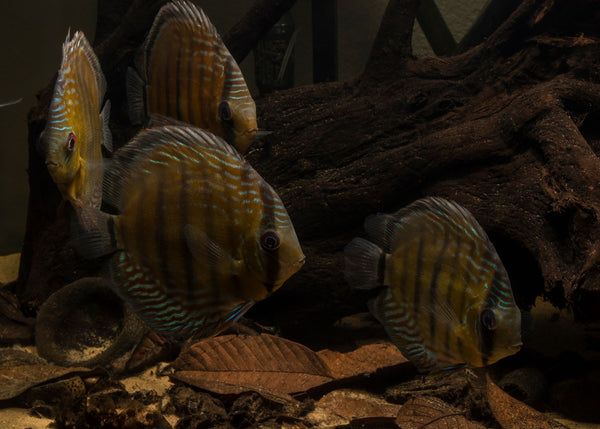- Continue Shopping
- Your Cart is Empty
Over time...
As you know, I spend a lot of time talking very critically about the short term mindset that seems to be pervasive in the hobby, seemingly enabled by the frenetic pace of tank "do-overs" in the aquascaping world. I sometimes worry if the art of long-term maintenance- or even the idea of keeping an aquarium set up over the long term- like- years versus, ya know- a few months (or a "contest period!")- is a reality that most newer hobbyists have thought of.

Yeah, it's a long game.
In our game, we talk a lot about establishing more natural-functioning/appearing systems, and many of the nuances associated with getting them up and running. However, we seem to spend a relatively small amount of time talking about what actually happens in these tanks over the very long term and how to manage them, right? With so many hobbyists getting into this style of aquarium for the first time, it's worth another look!
There are some characteristics of these types of tanks which require a fair amount of continued management that keep them functioning as blackwater tanks; most notably, the continuous addition of more botanical items to replace those which break down, be they leaves, wood, or seed pods and the like- in order to maintain not only the visual "tint", but the beneficial humic substances and other organics contained in these materials.

Over time, many of these compounds are dissolved into the water column, and these botanical materials will no doubt lose some of their efficacy as "environmental enhancers."

And obviously, this sort of "active management" not only creates a more stable environment for your fishes, it provides an opportunity to continuously engage with your aquatic environment on a very regular basis. Continuously replacing and adding more botanical materials over time is one of the most important aspects of managing this type of aquarium, and is especially critical in an environment in which the very structure of the aquascape itself evolves and changes over time!
Now, unlike other tanks I've managed over the years, such as reef aquariums, planted tanks, etc., where you need to sort of change or evolve your husbandry tasks as the tank ages (i.e.; pruning, revising fertilization schemes, etc.), the botanical-style natural aquarium seems to benefit from the same types of maintenance tasks throughout its functional lifetime.
Some hobbyists choose to let their botanical items remain in the system until fully decomposed; others prefer to remove items just as soon as they lose the "pristine show look." Regardless of how you handle the "botanical breakdown", you're more-or-less following the same practices over a long term.
Consistency. Our old friend.

And of course, water exchanges are as important a part of the management of our systems as any other. The dissolution of organics and "reset" that water exchanges provide are one of the "cornerstone" practices in aquarium husbandry, and will help continuously hold your environmental parameters.
As any aquarium ages, it's essential to at least have a handle on what is happening chemically. In the botanical-style, natural aquarium, it's nice to conduct basic water parameter tests early on in the tank's existence, to establish a reference "baseline" of the tanks typical "operating parameters".
In a typical tank, you may see a gradual reduction in pH over time. This may be caused by acids forming from accumulated nitrate and other nitrogenous compounds and over time, as they overwhelm the buffering capacity of the tank. This seems to be much more common in higher pH systems, such as African cichlid tanks, reef aquaria, etc.

You will likely find, as I have, that with the consistent management of your natural-style blackwater aquariums, very little in the way of "parameter shift" appears to occur. I've seldom noticed any sort of appreciable pH decline over time in these tanks (probably because you're starting out with lower pH!), and nitrate and/or phosphate levels tend not to vary significantly at all with consistent botanical replacements and water exchanges.
I'm curious what YOUR experience has been in this respect.
I also tend to monitor TDS a lot in botanical tanks, and I've found that I will see a "range" of 2-3 ppm at the most, in which the parameters seem to stay throughout the lifetime of the tank. Any deviation from this should be something that you should investigate. Not necessarily a "bad" thing, as TDS can be just about anything...yet it does function as a sort of "yardstick" for environmental consistency.
Ah..consistency over time again.

One physical maintenance task that I have found to be continuous and necessary is the cleaning of filter intakes, mechanical filter media, and water pumps. With a constantly-decomposing array of botanical materials streaming into the water column, lots of small debris tend to get sucked into filter intakes, pumps, and of course, mechanical filter media. These need to be cleaned/replaced on a regular basis; perhaps even more frequently than other maintenance tasks.
It's simply part of the game when working with a botanical-style blackwater aquarium!

Nothing we've mentioned here is earth-shattering or revolutionary, from an aquarium husbandry standpoint. However, seeing that for many hobbyists, this is their first experience at managing a botanical-style blackwater aquarium, and with tons of information out there stressing concepts like breaking down a tank after a few months, I think it's not a bad idea to review this sort of stuff from time to time!
In natural-style aquariums, seldom are big moves or corrections required. Rather, it's really a combination of little things, done consistently over time, which will see your aquarium thrive in the long run.
Yeah, over time.

Stay consistent. Stay observant. Stay engaged.. Stay involved...
And Stay Wet.
Scott Fellman
Tannin Aquatics









Scott Fellman
Author